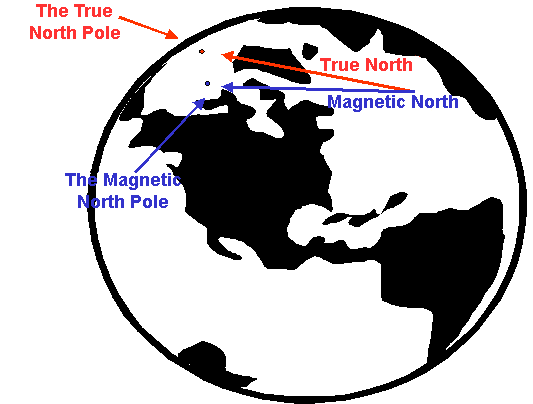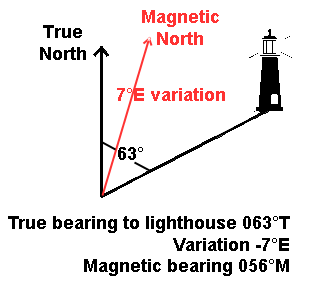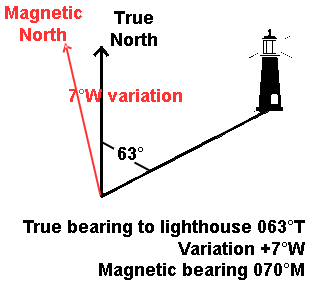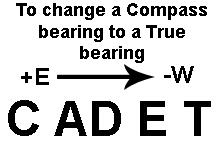Navigation and Chart work - Compass Variation
Compasses
A compass will point north, but unfortunately for mariners there are several things which affect where the compass indicates north to be.
Variation
Variation will nearly always be a factor in navigation. It is caused by the difference in position of the True North Pole and the Magnetic North Pole. The True North Pole is where charts are lined up on; all the lines of longitude run up to the True North Pole. The Magnetic North Pole is where our compasses point; it is near to Canada.
The effect of this is that in most parts of the World there is Variation. However, variation changes with position around the World. In some places, like the eastern Mediterranean Sea, where the two poles appear to be in line, variation is minimal. From the central North Atlantic, variations can be as much as 20° west. Whereas, in the Pacific Ocean, variation becomes easterly.

Local variation is indicated on the compass roses. Look at Chart 1, in the north-east corner, the variation is 7° 15'W. In the north-west corner it is 7° 30'W.
So even over this small distance, there is a difference.
Find the variation at any place. (Magnetic Declination is another name for variation)
Chart of variation around the World.
In addition, to variation changing with position, it also changes over time. This is caused because the position of the Magnetic North Pole moves in a small circle around the True North Pole over hundreds of years.
This annual change is indicated by the figure in brackets. On Chart 1, it is 6'E. This means that the variation is decreasing by 6' each year.
To find the variation for any given year we need the variation from the compass rose and the year for which it was correct, then add or subtract the annual change.
Variation 7° 15'W in 1997
Change -54'E (9 years at 6'/year)
Variation 6° 21'W in 2006
This would be rounded up or down to the nearest whole degree for practical use. So the variation in 2006 is 6° W.
To understand how we apply variation, see the diagrams below.


You can see that sometimes you add the variation and sometimes you subtract it.
There are may rules and mnemonics to help you to do this, at first it seems difficult but when you have been doing this for a while you will be able to do it without a problem.
Many people use the word:

Compass bearings are magnetic, which is where the C of CADET comes from. From Compass, AD East to get a True bearing.
If you have a Magnetic bearing of 100°M with a variation of 5°E, the True bearing would be 100 + 5 = 105°T
If you have a Magnetic bearing of 100°M with a variation of 5°W, the True bearing would be 100 - 5 = 095°T
From this one idea we can deduce all the other situations. If we are changing a bearing from Magnetic to true, when there is a west variation, we reverse the sign and subtract the variation.

For changes from True to Magnetic the situations are reversed. See the full diagram above.
If you have a True bearing of 100°T with a variation of 5°E, the Magnetic bearing would be 100 - 5 = 095°M
If you have a True bearing of 100°T with a variation of 5°W, the Magnetic bearing would be 100 + 5 = 105°M
It can be useful to print the CADET rule on to a label and stick one on your training charts or navigation plotter.
It is vital that you also note if a bearing is True - T, or Magnetic - M.
On the south coast of the UK, variation is about 3°W at present, when it is such a small figure that on short passages it will not make much difference if you get your calculations wrong. However, it is easy now to get on a plane and charter a boat in the Caribbean where variation can be 15°W or New Zealand where it can be 20°E. In these area, carelessness with variation calculations could be disasterous.
Convert these true bearings to magnetic bearings.
1. 060°T Variation 10°W.
2. 040°T Variation 10°E.
3. 345°T Variation 8°E.
4. 352°T Variation 12°W.
5. 003 °T Variation 6°E.
Convert these magnetic bearings to true bearings.
6. 009°M Variation 19°E.
7. 000°M Variation 5°W.
8. 000°M Variation 10°E.
9. 345°M Variation 25°E.
10. 009°M Variation 11°W.
Additional Resources:

